19 Natural Bedding Ideas for Eco-Friendly Comfort
I have been, or can be if you click on a link and make a purchase, compensated via a cash payment, gift, or something else of value for writing this post. As an Amazon Associate, I earn from qualifying purchases. Please read my full Affiliate Disclosure for more information.
Imagine slipping into a bed that feels like a gentle hug from nature itself—peaceful, pure, and incredibly cozy. Natural bedding ideas have surged in popularity because they promote healthier sleep environments, are eco-friendly, and add a touch of serenity to any bedroom. Choosing sustainable materials not only benefits the planet but also transforms your space into a sanctuary of comfort.
In this article, you’ll find a variety of inspiring natural bedding ideas that suit every style and preference. From organic cotton sheets to bamboo blankets and handmade textiles, these ideas will help you create a cozy, eco-conscious retreat that elevates your sleep experience and supports a sustainable lifestyle.
1. Organic Cotton Duvet Covers in Earth Tones
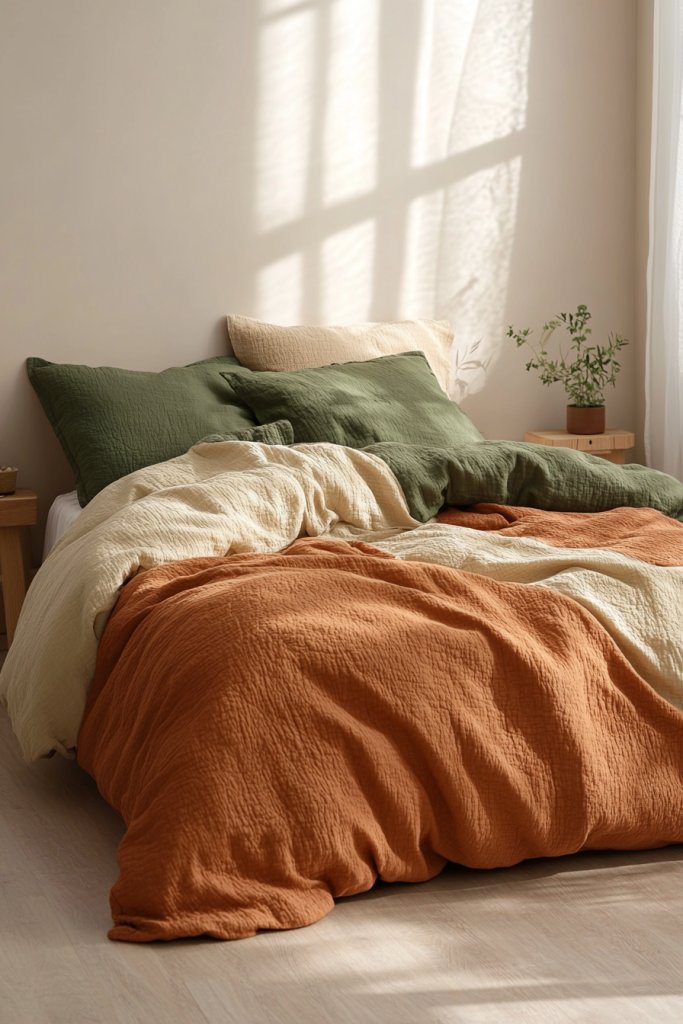
Ever wish your bed could feel like a cozy retreat without harming the planet? Finding bedding that’s both lush and eco-friendly can seem like a tall order, especially with so many synthetic options flooding the market. Many of us want a sustainable sleep haven that doesn’t compromise comfort or style. The good news? Organic cotton duvet covers come to the rescue, blending eco-consciousness with plush softness.
Picture wrapping yourself in a buttery-soft duvet cover in shades of warm terracotta, muted olive, or sandy beige. The fabric’s matte finish offers a natural, relaxed vibe, while the breathable weave invites cool breezes in summer and cozy warmth in winter. Layered with textured throws and plush pillows, the bed feels inviting and effortlessly stylish. The earthy tones evoke a calming atmosphere, making your bedroom a true sanctuary.
You can match these covers with minimalist neutral sheets or bold accent pillows for a pop of color. Seasonal swaps, like swapping earthy tones for bright pastels or deep jewel hues, keep the look fresh year-round. For a more rustic look, pair with linen sheets or add a chunky knit throw. Small spaces benefit from lighter shades, while larger rooms can handle richer, deeper earth tones for added depth.
Start by choosing organic cotton duvet covers made from GOTS-certified fabric, ensuring no harmful chemicals are involved. Measure your duvet insert to pick the right size—nothing worse than a cover that’s too tight or too loose. Look for natural dyes or undyed fabrics to maximize eco benefits. Washing in cold water with a gentle, plant-based detergent preserves fabric integrity and color. Air dry when possible to extend lifespan and avoid energy use from dryers.
Personalize your bedding with embroidery or subtle stitching in contrasting thread for a handcrafted feel. Incorporate decorative piping or textured borders for added detail. Use biodegradable silk or cotton ribbon ties to secure the duvet inside, avoiding synthetic fasteners. You can also mix and match earth tones to build a layered, bespoke look that reflects your personality.
Switching to organic cotton duvet covers is a small change that makes a big impact—both on your comfort and the environment. It’s a stylish, sustainable choice that aligns with a greener lifestyle. Plus, knowing your bedding is free from toxins gives you peace of mind every night. Ready to transform your sleep space into a cozy, eco-chic haven?
2. Linen Sheets with Textured Finish
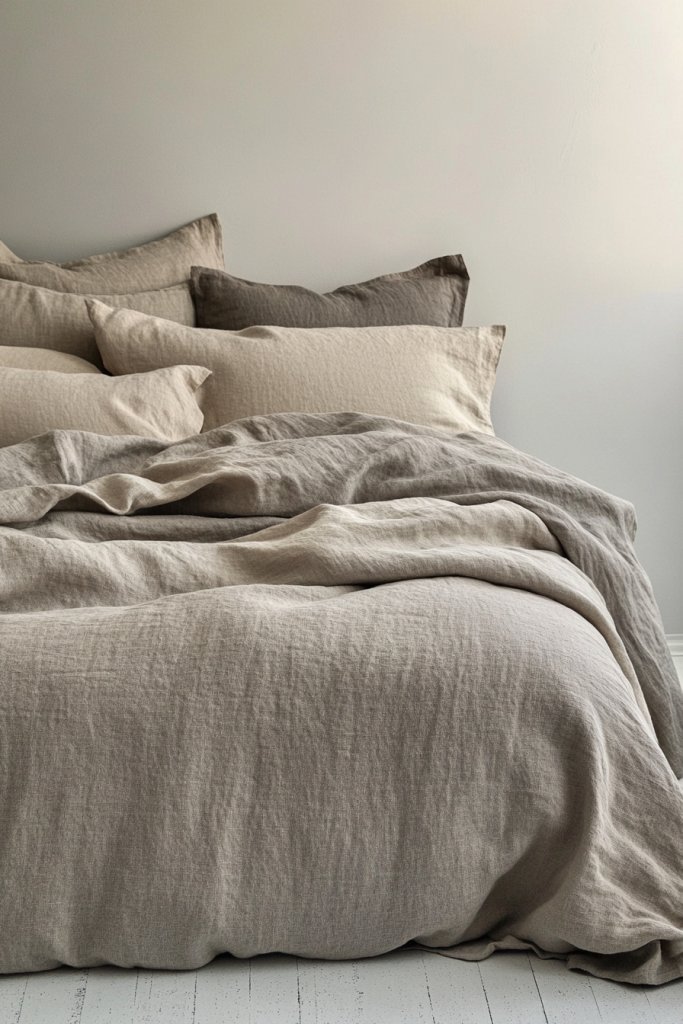
Ever find yourself yearning for that effortlessly chic, lived-in look in your bedroom? Conventional sheets often feel too smooth or slick, lacking character and natural appeal. Many of us want bedding that’s both breathable and stylish, without sacrificing sustainability. Linen sheets fit the bill perfectly, offering a textured finish that gets better with age.
Imagine running your fingers over a set of slightly crinkled linen sheets in a soft, muted gray or warm taupe. The textured surface adds depth, making the bed look inviting and relaxed. The fabric’s matte finish absorbs light softly, creating a calming vibe. In the morning, the slight rumples give a cozy, casual feel that invites you to sink right in.
Pair linen sheets with smooth, crisp cotton pillowcases for contrast or go all-in with layered textured bedding for a boho look. Bright whites evoke a fresh, airy feel, while deeper shades add sophistication. For seasonal adaptability, add a lightweight throw in winter or a breathable coverlet in summer. Linen’s durability means it can handle frequent washing, maintaining its charm over the years.
Choose high-quality, 100% linen sheets from reputable sustainable brands. Pre-wash to remove excess starch and enhance softness—linen often benefits from a few wash cycles. Look for natural, undyed or lightly dyed options to maximize eco benefits. Linen is naturally hypoallergenic and moisture-wicking, making it ideal for hot or humid climates. Keep in mind that linen wrinkles easily—embrace the relaxed look or smooth it out with a quick iron.
Add decorative borders or subtle embroidery along the edges for a personalized touch. Mix linen sheets with other natural textiles, like cotton or hemp, to create a layered, textured aesthetic. Use contrasting stitch colors or add a decorative hem for visual interest. For a more luxe vibe, incorporate a silk or velvet throw at the foot of the bed.
Linen sheets are a timeless staple that elevate any bedroom with their natural charm. They promote better sleep thanks to their breathability and moisture-wicking properties. As they age, linen develops a unique character that only enhances their appeal. Embrace the imperfect beauty of linen and enjoy a more relaxed, eco-friendly sleep environment.
3. Recycled Fabric Patchwork Quilts
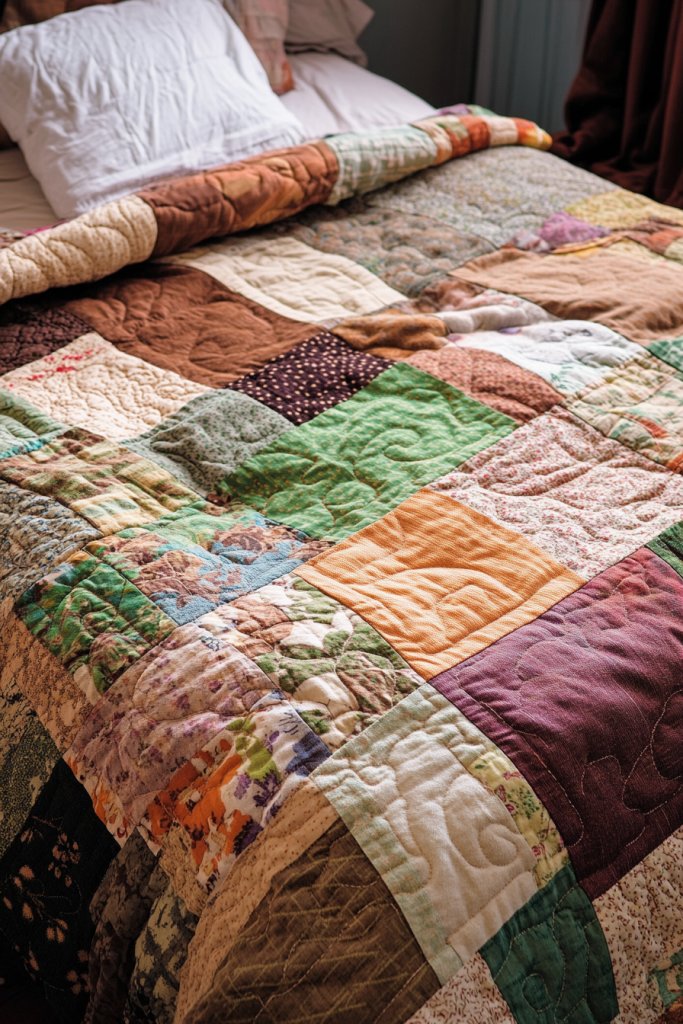
Looking for a bedding piece that combines sustainability with personality? Mass-produced quilts can feel generic, but a patchwork quilt made from recycled fabrics offers a charming, eco-friendly alternative. It’s a way to add a handcrafted touch to your bedroom while reducing waste. Plus, these quilts are often one-of-a-kind and full of character.
Visualize a vibrant quilt with patches of vintage floral cotton, denim scraps, and textured linen pieces stitched together in an eclectic pattern. The mix of colors and textures creates a lively focal point on your bed. The visible stitches and varied fabrics give it a rustic, artisanal vibe. When draped over a neutral bed frame, it instantly elevates the space into a cozy, story-rich retreat.
Use a patchwork quilt as a statement piece or layer it with plain sheets and throws for a more subdued look. You can choose quilts with bright, cheerful colors for a playful vibe or muted tones for a more sophisticated atmosphere. Seasonal swaps are easy—add a heavier, insulated quilt in winter or a lightweight one for summer. You can also incorporate reclaimed fabric accents into other bedding layers.
Opt for handmade or carefully curated recycled fabric quilts from artisans or eco-conscious brands. Look for quilts that clearly indicate the use of recycled or upcycled materials. If you’re DIY-inclined, gather scraps from old clothing, curtains, or fabric remnants, then sew your own patchwork. Use durable, eco-friendly thread and machine or hand-stitch the patches securely. Finish with a natural fiber backing for added sustainability.
Personalize your patchwork quilt by choosing patches that tell a story—vintage fabrics, meaningful colors, or textured textiles you love. Embroider initials or simple motifs to add a bespoke touch. Incorporate patches with different textures like boucle, chambray, or linen for extra sensory appeal. Hang small fabric tags with stories or dates for a sentimental touch.
Recycled fabric patchwork quilts prove that sustainability and style go hand in hand. Each quilt becomes a unique piece that supports a circular economy. Plus, they add warmth and charm to any bedroom. Think of it as a cozy, eco-friendly heirloom that can be passed down through generations.
4. Bamboo Bedding Sets for Softness and Sustainability
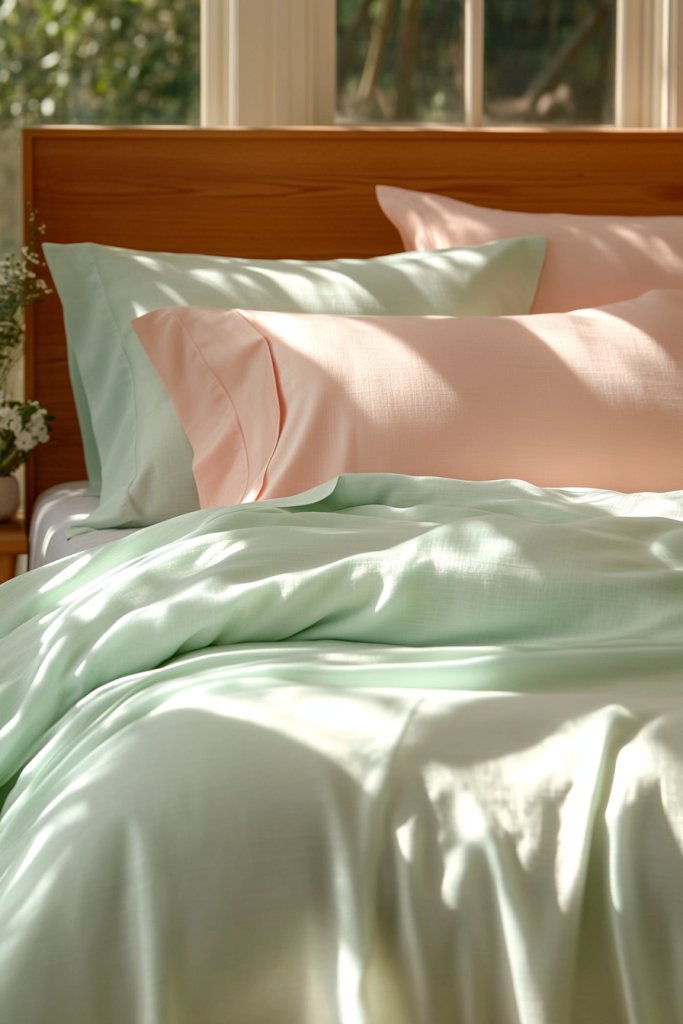
Ever wished your bedding could feel as silky as luxury hotel linens but without the environmental guilt? Bamboo fabric has gained popularity for being both incredibly soft and eco-friendly. It’s a sustainable choice that offers a smooth, breathable surface for restful sleep. The best part? It naturally resists odors and bacteria, making it a hygienic option.
Imagine slipping into a set of bamboo sheets in a calming sage green or soft cream. The fabric’s silky sheen invites a luxurious feel, while its gentle drape creates a relaxed, inviting look. The lightweight material feels cool to the touch, perfect for warm nights. The subtle stretch and smooth texture make every night feel like a pampering retreat.
Pair bamboo sheets with neutral-toned pillowcases or add colorful, patterned throws for contrast. For a spa-like aesthetic, combine with white or pastel linens and a plush, textured blanket. Bamboo’s versatility allows for layering—use lightweight sheets in summer and add a cozy duvet or blanket in winter. Its durability makes it suitable for frequent washing without losing softness.
Choose bamboo bedding from certified eco-friendly brands that use organic farming practices. Look for fabrics labeled OEKO-TEX certified to ensure no harmful chemicals are involved. Wash in cold water with eco-friendly detergent to preserve natural fibers. Avoid fabric softeners and bleach, which can damage bamboo’s delicate structure. Air dry or tumble dry on low heat to extend longevity.
Add embroidery, monograms, or decorative stitching to make your bamboo bedding unique. Use contrasting piping or decorative trims in natural fibers for a subtle upgrade. Mix bamboo sheets with textured throws or velvet pillowcases for a layered, luxurious feel. Create a calming color palette by combining different shades of green, beige, or gray.
Bamboo bedding sets are a practical way to align luxury with sustainability. They promote better sleep with their breathability and moisture-wicking qualities. Plus, supporting bamboo farming helps reduce deforestation and soil erosion. It’s a smart, stylish upgrade for eco-conscious sleepers ready to indulge.
5. Hemp Bed Linens for Durability and Eco-Consciousness

Looking for bedding that’s tough, breathable, and kind to the planet? Hemp fabric stands out for its incredible durability and low environmental impact. It’s naturally resistant to pests and requires minimal water and pesticides to grow. If you want bedding that lasts for years and reduces your ecological footprint, hemp is a smart choice.
Envision a set of hemp sheets in earthy tones like deep olive or rich taupe. The slightly coarse texture adds a natural, rustic charm, gradually softening with each wash. The fabric’s matte finish and subtle weave create a grounded, organic aesthetic. Layered with textured blankets or linen pillows, the bed exudes a relaxed, eco-conscious vibe.
Combine hemp sheets with cotton or linen for a mixed-texture look that’s both stylish and functional. Use in minimalist bedrooms for a clean, natural appearance, or add decorative throws and pillows for a layered effect. In cooler months, layer with warm wool blankets for added insulation. Hemp’s durability means it can withstand frequent washing and heavy use.
Choose hemp bedding from brands committed to organic farming and sustainable practices. Look for certifications like GOTS or OEKO-TEX. Wash with cold water and mild, plant-based detergents—avoid bleach or harsh chemicals. Hemp naturally resists wrinkling but can be pressed or smoothed out with a warm iron if desired. Store in a cool, dry place to prolong lifespan.
Personalize with contrasting topstitching or decorative embroidery on pillowcases. Incorporate textured or patterned hemp blends for visual interest. Use natural fiber trims or decorative ties to secure bedding. Pair with other sustainable textiles like organic cotton or recycled wool for a cohesive, earthy aesthetic.
Hemp linens prove that durability and sustainability can go hand in hand. They support regenerative agriculture and help reduce chemical use. The natural texture and resilience of hemp bedding make it a practical, stylish upgrade for eco-minded sleepers. Feel confident knowing your bedding supports a healthier planet.
6. Organic Wool Blankets for Warmth and Natural Insulation
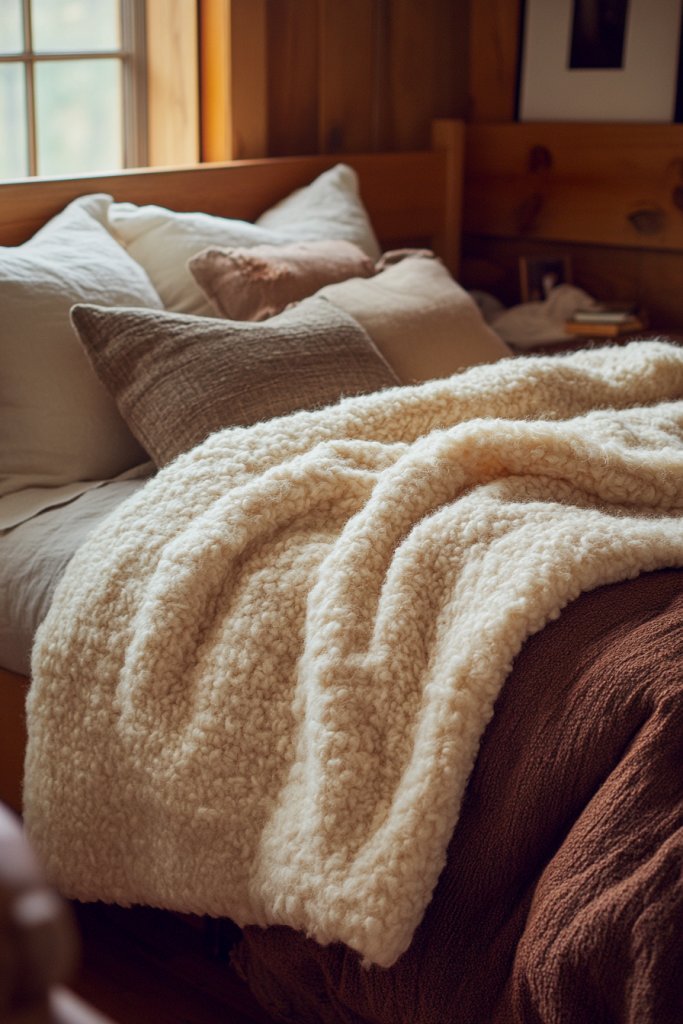
Ever struggle to stay warm without turning to synthetic, chemical-laden blankets? Organic wool blankets offer natural insulation that keeps you cozy all night long. They’re breathable, moisture-wicking, and free from synthetic dyes or treatments. If comfort and sustainability are your priorities, wool blankets are a game changer.
Picture a thick, hand-knit wool blanket in a natural cream or charcoal gray draped over your bed. The textured stitches add visual interest and a tactile richness that invites touch. The blanket’s weight and warmth radiate comfort, while the natural fibers breathe to prevent overheating. It’s both functional and decorative—a perfect blend.
Layer an organic wool blanket with lighter linen or cotton sheets for year-round comfort. Use in rustic, Scandinavian, or boho bedrooms to enhance the natural aesthetic. In winter, add a plush faux fur throw or a chunky knit coverlet for extra warmth. For summer, fold it at the foot of the bed or use as a decorative accent.
Choose organic wool blankets certified by GOTS or OEKO-TEX for chemical-free processing. Hand or machine wash in cold water using gentle, eco-friendly detergents. Avoid fabric softeners, which can coat fibers and reduce breathability. Air dry flat to maintain shape and texture. Wool’s natural lanolin provides antimicrobial benefits, reducing odor buildup.
Add decorative edgings or embroidered details for a bespoke look. Mix different textures like boucle or chunky knits for visual interest. Use colorful, natural fiber trims or decorative ties to customize the edges. Pair with eco-friendly, textured pillow covers for a layered, inviting bed.
Organic wool blankets blend functionality with eco-consciousness, making them a smart, stylish choice. They support sustainable wool farming practices and promote healthier indoor air quality. Embrace natural insulation and timeless style for a bedroom that nurtures both body and planet.
7. Cork Mattress Protectors for Natural Barrier and Support
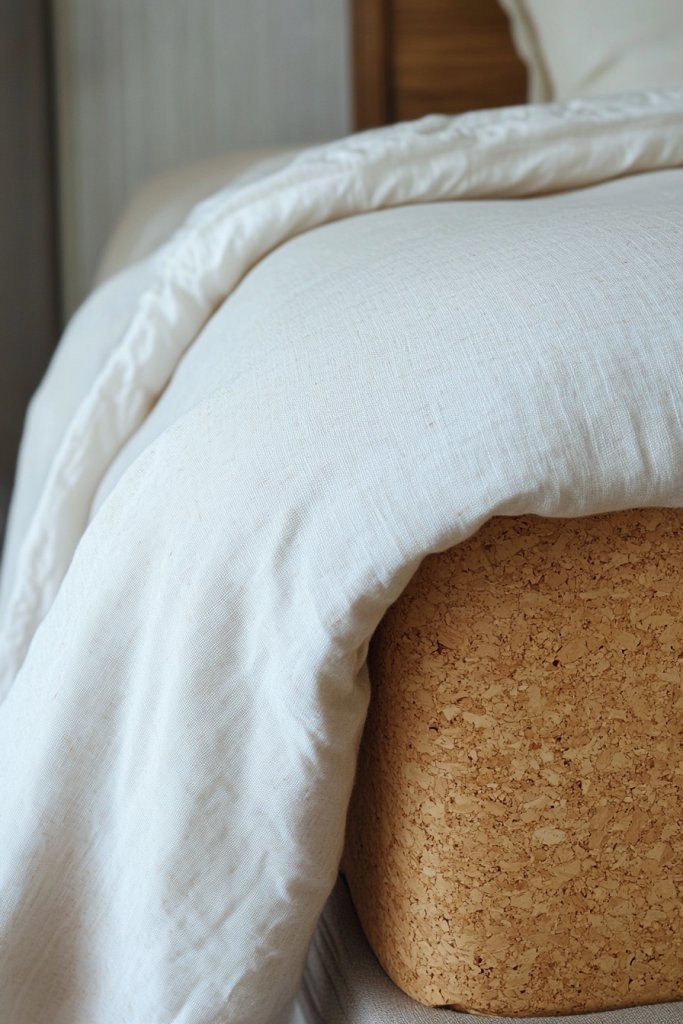
Tired of synthetic mattress protectors that trap heat and off-gas chemicals? Cork offers a natural, antimicrobial barrier that keeps your mattress fresh and protected. It’s a sustainable, biodegradable material that enhances support while maintaining eco-friendly standards. If you crave a healthier sleep environment, cork is your new best friend.
Imagine a sleek, thin cork protector with a textured surface that molds seamlessly over your mattress. The warm, earthy tone complements natural bedding, creating a grounded aesthetic. Its slightly spongy feel adds a subtle support layer, and its natural grain pattern lends an organic charm. The protector’s close fit ensures a smooth, comfortable sleeping surface.
Use cork mattress protectors under organic cotton or linen sheets to reinforce eco-friendly bedding sets. For added support, layer with natural latex toppers or wool pads. In warmer climates, opt for breathable cork to enhance airflow. For a more luxurious look, pair with textured throws or decorative pillows in natural fibers.
Select a cork protector certified for sustainability and antimicrobial properties. Measure your mattress accurately before purchasing for a snug fit. Install the protector directly on the mattress, ensuring all corners are secured. It requires minimal maintenance—simply wipe clean with a damp cloth and air out regularly. Cork’s natural antimicrobial qualities help keep allergens and bacteria at bay.
Add a decorative border or subtle embossing to customize your cork protector. Use organic, dye-free linens and textured throws to complete the eco-friendly look. Consider layering with a natural latex or wool topper for extra comfort and insulation. Keep the aesthetic earthy and minimal for a calming retreat.
Cork mattress protectors are a smart, sustainable choice that supports healthier sleep and reduces chemical exposure. They blend support, hygiene, and eco-consciousness effortlessly. Feel confident knowing your sleep setup aligns with your values while providing comfort that lasts.
8. Wool or Cotton Mattress Toppers for Comfort and Eco-Friendliness
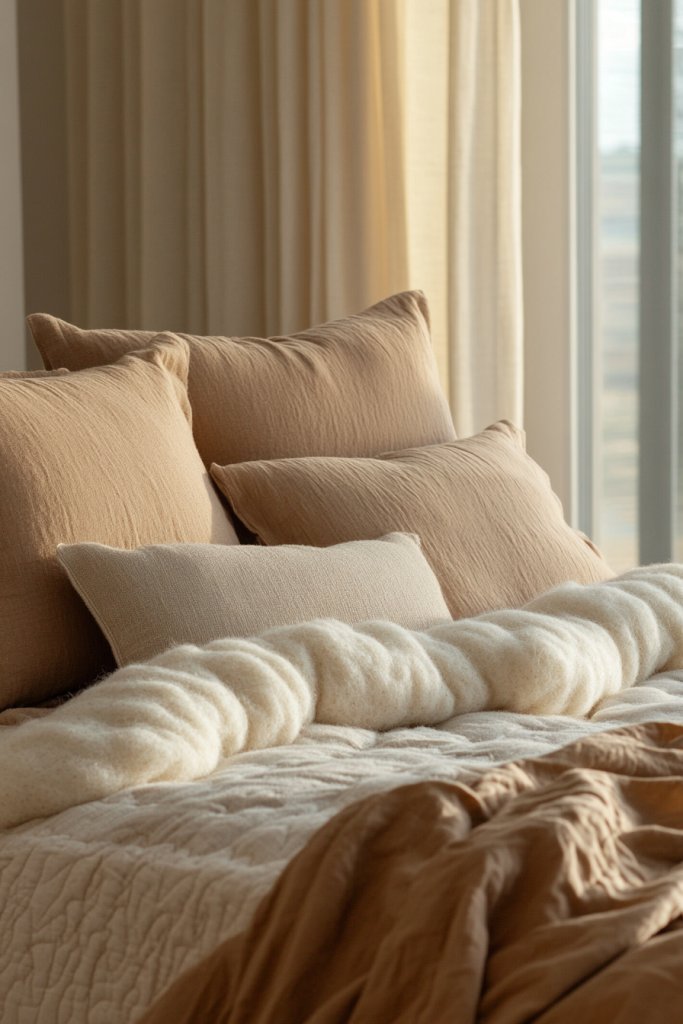
Ever wake up feeling sore because your mattress lacks enough padding? An eco-friendly mattress topper can instantly upgrade your sleep comfort without buying a whole new bed. Natural wool or organic cotton toppers provide cushioning and support while keeping things sustainable. It’s a simple fix with big benefits.
Picture a plush wool topper with a soft, textured surface in creamy white or natural beige. The fibers gently cradle your body, offering a luxurious layer of comfort. The topper’s breathable nature prevents overheating and moisture buildup. When placed on your mattress, it creates a cozy, inviting space that feels like a personal retreat.
Use wool toppers in colder months to add insulation or switch to organic cotton for a cooler, breathable layer in summer. For extra style, cover the topper with a decorative woven or textured cover. Layer multiple toppers for customizable firmness or softness. They work well with both minimalist and layered bedding aesthetics.
Choose toppers made from organic wool or cotton, certified by GOTS or OEKO-TEX. Measure your mattress carefully to select the right size. Place the topper directly on the mattress and secure with fitted sheets or elastic straps. Regularly air out and spot clean with eco-friendly detergents. Wool toppers may require gentle hand washing, while cotton ones are machine washable.
Add a decorative cover or quilting pattern for visual appeal. Use contrasting piping or embroidered details for a bespoke touch. Incorporate a layer of natural fiber batting or textured fabric to enhance aesthetics. These personalized touches make your sleep setup uniquely yours.
Natural toppers are a cost-effective way to improve sleep quality sustainably. They extend the life of your mattress and support eco-conscious living. Enjoy waking up refreshed knowing your bedding choices support a healthier planet and better sleep.
9. Handmade Loops and Knots with Natural Fibers for Decorative Accents
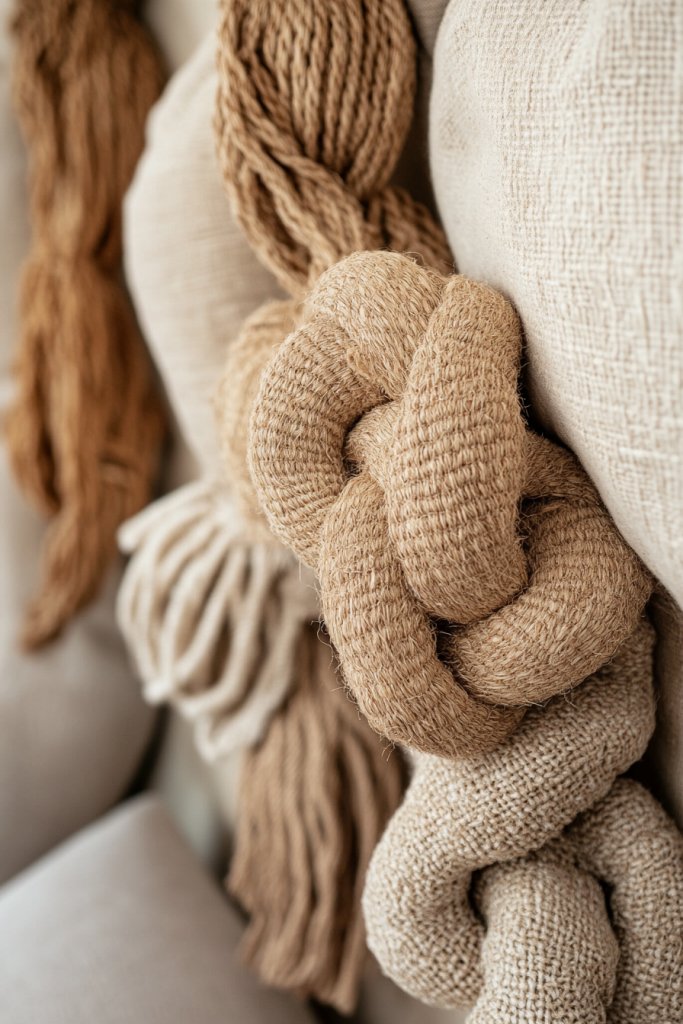
Want to add a handmade, artisanal touch to your bedding that’s both sustainable and stylish? Natural fiber loops and knots are a playful way to personalize your bed without relying on mass-produced decor. They bring a rustic charm and tactile interest that elevates any bedroom. Plus, they’re easy to make or source from eco-friendly artisans.
Imagine a set of linen or cotton fabric loops with intricate knots and tassels, hanging at the foot or side of your bed. The natural fibers—jute, hemp, or organic cotton—offer a tactile contrast to smooth sheets. The handcrafted details create a cozy, boho vibe, with textures that invite touch and admiration. The neutral tones blend seamlessly with earthy bedding palettes.
Use decorative knots as curtain tiebacks or attach them to pillowcases for a whimsical touch. Incorporate natural fiber tassels or loops into a DIY headboard or draped across the bed frame. They work well in boho, rustic, or Scandinavian-inspired spaces. Choose fibers in shades that complement your bedding for a cohesive look.
Source natural fiber cords or strips from eco-friendly suppliers or craft your own from leftover fabric. Knot or loop the fibers into decorative shapes, securing with eco-friendly glue or stitches. Attach them to existing bedding with simple sewn loops or clips. For a more polished look, consider adding beads or small wooden accents. Maintain by gently cleaning with a damp cloth.
Create custom patterns or symbols with knots to express personal meaning. Use contrasting colors or layered fibers for visual depth. Embellish with natural wooden or ceramic beads for added detail. These accents can also serve as functional hooks for lightweight items.
Natural fiber knots and loops are a beautiful way to support artisanal crafts and sustainable materials. They make your bedroom uniquely personal and eco-conscious. Enjoy the tactile richness and the sense of handcrafted authenticity they bring to your space.
10. Dyes from Plant-Based Sources for Custom Colors

Tired of synthetic dyes that can contain harmful chemicals? Plant-based dyes offer a natural, safe way to add color to your bedding. They’re eco-friendly, non-toxic, and often produce unique, subtle hues that deepen with each wash. Want your bed to look vibrant and sustainable? This is your answer.
Imagine bedding in soft shades of indigo, rust, or sage, achieved from extracts of indigo plants, madder root, or eucalyptus. The colors are often muted and layered, creating a calming, organic aesthetic. The textures remain soft and inviting, while the hues evoke a connection to nature. Subtle variations in tone add depth and personality.
Combine naturally dyed sheets with neutral or contrasting plain fabrics for a layered look. Use different plant dyes for pillowcases, throws, or decorative accents to create a harmonious palette. Seasonal color swaps—like deep reds for fall or fresh greens for spring—keep your bedding dynamic and fresh.
Source fabrics pre-dyed with plant-based colors from artisans or dye your own using eco-friendly extracts. Prepare natural dyes by simmering plant materials in water, then soak your fabric for hours or days depending on the depth of color desired. Fix the dye with natural mordants like alum or iron. Rinse thoroughly in cold water to set the color and preserve the hue.
Create custom patterns or ombré effects by immersing parts of the fabric in dye baths. Add subtle embroidery or stitching to highlight the colors. Mix dyed fabrics with plain linens for a sophisticated, layered effect. Keep fabric in a cool, dark place to prevent fading.
Plant-based dyes connect your bedding to the earth and its cycles, promoting a more mindful lifestyle. Each piece becomes a conversation starter about sustainability and creativity. Embrace the beauty of natural hues that age gracefully, adding warmth and character to your space.
11. Zero-Waste Bedding with Reversible Designs
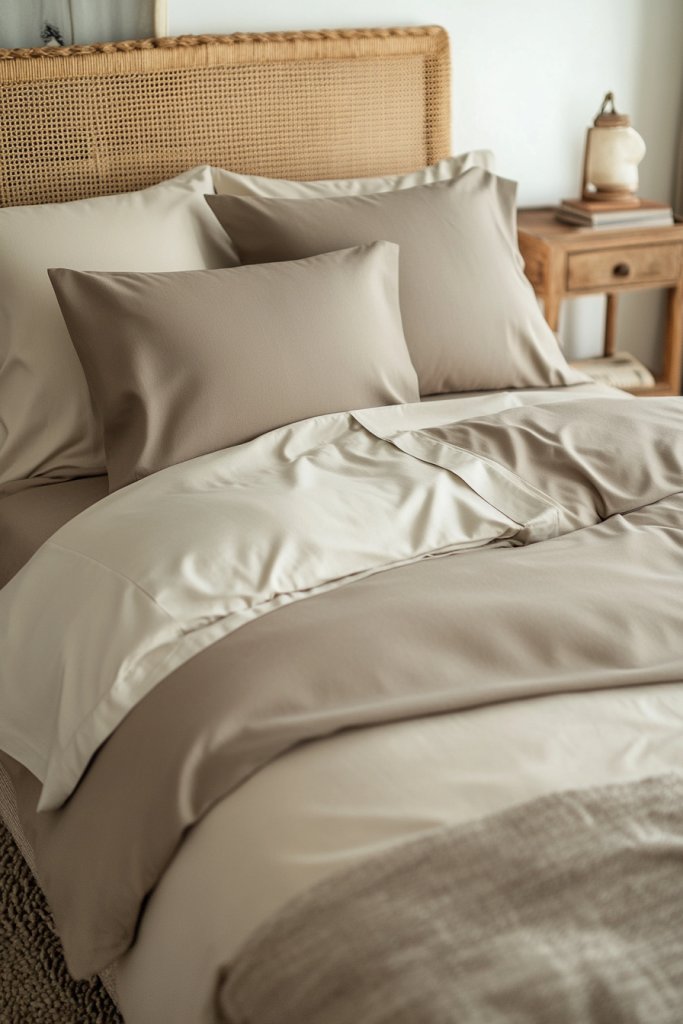
Are you tired of bedding that wears out or goes out of style quickly? Zero-waste, reversible bedding offers a sustainable solution that doubles your options and extends the life of your investment. It’s a clever way to reduce fabric waste while keeping your bedroom fresh and versatile.
Imagine a set of bedding with one side featuring a subtle, neutral pattern and the other a bold, colorful geometric design. When you want a change, simply flip the duvet or pillowcases for a whole new look. The reversible design not only adds visual variety but also minimizes waste by maximizing fabric use. The fabrics are soft, textured, and crafted with eco-conscious techniques.
Mix and match reversible bedding with non-reversible sheets or throws to create layered, adaptable aesthetics. Use seasonal color schemes—light and airy for summer, richer hues for winter—by flipping or rotating pieces. Choose designs that complement multiple decor styles, from minimalist to boho, for maximum flexibility.
Select bedding made from natural, eco-friendly fabrics that are designed to be reversible, like organic cotton or linen. Ensure the pattern or color on both sides is coordinated and durable. Wash gently with eco-friendly detergents to preserve the patterns. When washing, separate dark and light colors to prevent bleeding. For added longevity, avoid over-drying and opt for air drying.
Add personal touches by choosing reversible covers with subtle embroidery or textured accents on both sides. Incorporate decorative trims or piping that highlights the reversible nature. Use natural, biodegradable fasteners or ties to secure pillowcases or duvet covers. Create your own reversible pieces by sewing fabric scraps together in symmetrical patterns.
Zero-waste, reversible bedding is a smart, eco-conscious way to refresh your bedroom without excess waste. It encourages creativity and flexibility, letting you adapt your decor to your mood or season. You’re making a positive impact with every flip and fold—beauty and sustainability in harmony.
12. Layered Bedding with Organic Throws and Coverlets
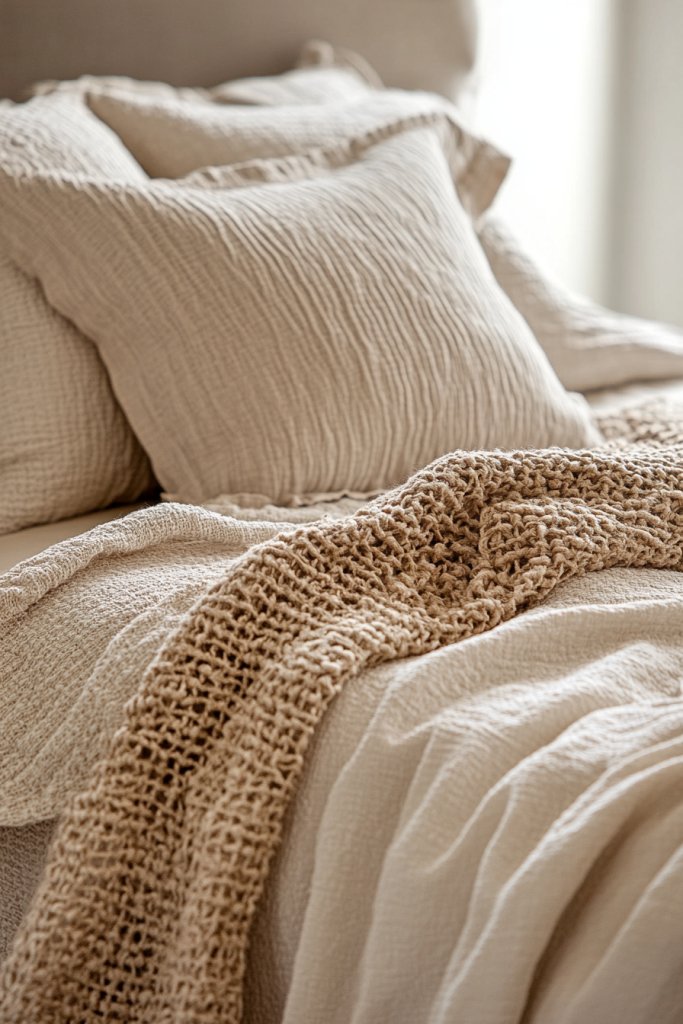
Ever feel your bed looks flat or boring no matter how much you fluff? Layering organic throws and coverlets adds depth, texture, and warmth to your bedding. It’s a simple way to elevate your bedroom’s style while staying committed to eco-friendly choices. Plus, it’s versatile enough to adapt to any season.
Picture a neatly made bed topped with a soft, chunky-knit throw in earthy tones, layered over a lightweight organic cotton coverlet in a subtle pattern. Add textured pillows and a woven blanket for contrast. The combination creates a rich, inviting look that feels cozy yet sophisticated. The layers invite you to snuggle in and relax.
Use lightweight throws in summer and heavier, textured coverlets in winter for seasonal adaptability. Mix textures like wool, cotton, linen, and knitted fabrics for a tactile-rich aesthetic. Play with color schemes—neutral tones for calm, vibrant hues for energy. Layering allows you to change the mood without replacing your entire bedding set.
Choose organic throws and coverlets made from natural fibers—wool, cotton, or linen. Layer them on top of your existing sheets and duvet for a curated, styled look. Use decorative stitching or fringed edges to add visual interest. Wash and care according to the fabric’s instructions, typically gentle cycles for longevity. Combine different textures for a cozy, eclectic vibe.
Add embroidered or appliqué details to throws for a personal touch. Incorporate natural fiber trims or decorative tassels. Use matching or contrasting colors to emphasize the layered look. Personalize with eco-friendly patches or labels that tell a story about your sustainable lifestyle.
Layered bedding not only looks great but also enhances comfort and warmth. It’s a flexible styling method that can evolve with your tastes and seasons. Creating a cozy, textured bed supports a restful sleep environment that aligns with eco values. Your bedroom becomes a sanctuary of style and sustainability.
13. Minimalist Bedding in Neutral, Unsaturated Tones
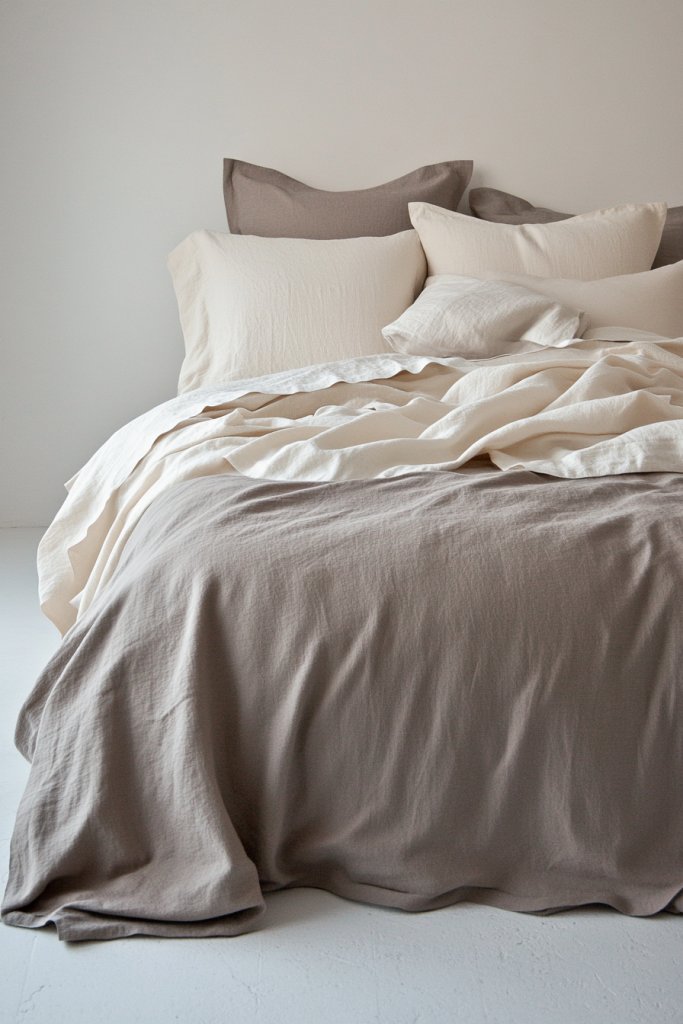
Feeling overwhelmed by busy patterns and bright colors in your bedroom? Minimalist bedding in neutral, unsaturated tones offers a calming escape from visual clutter. It’s perfect for creating a serene, clutter-free space that promotes relaxation and mindfulness. Less is more, especially when it comes to sustainable design.
Imagine a bed made with soft, undyed linen or organic cotton sheets in shades of beige, taupe, or soft gray. The simplicity of the colors emphasizes clean lines and natural textures. A few carefully chosen pillows and a textured throw complete the look, maintaining a tranquil, uncluttered aesthetic. The overall effect is a peaceful retreat that invites restful sleep.
Pair neutral bedding with wooden or bamboo accents and natural fiber rugs for a cohesive, eco-inspired look. Layer with textured throws or cushions in similar tones for depth. Seasonal variations can include adding a darker gray or muted pastel for contrast, or keeping it all light for summer. This style suits small spaces by enhancing the sense of openness.
Select high-quality, natural fiber sheets with simple, elegant weaves. Keep the bedding free of synthetic dyes or chemicals. Maintain with gentle, eco-friendly detergents and air drying to preserve fibers. Emphasize quality over quantity—invest in durable, timeless pieces that will last for years. Minimalist design thrives on clean, clutter-free presentation.
Add subtle embroidery or textured stitching for a bespoke touch without disrupting the minimalist aesthetic. Use natural, unbleached fabrics and simple decorative trims. Incorporate eco-friendly, handcrafted accessories like woven baskets or wooden trays nearby to complement the look. Keep accessories minimal and purposeful.
Minimalist bedding promotes a clutter-free mind and a more sustainable lifestyle. It’s a timeless, versatile choice that can easily adapt to changing tastes. When your bed looks effortlessly elegant, it encourages calm and well-being every day. Simplify to amplify your eco-conscious living.
14. Natural Fiber Mattress Covers for Breathability and Freshness
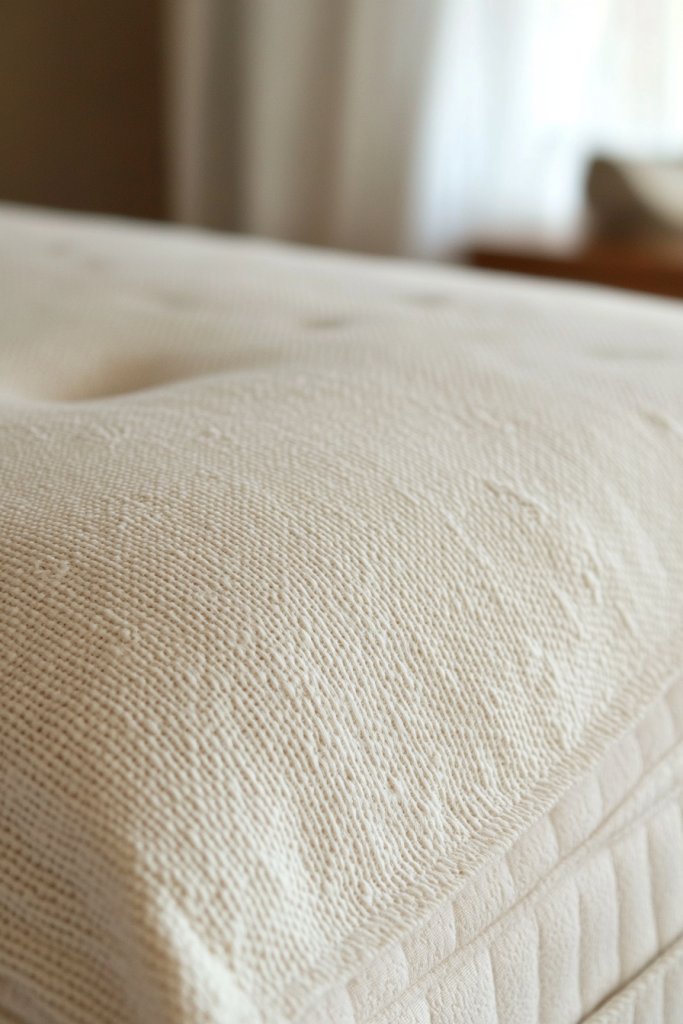
Want to keep your mattress fresh and free from synthetic chemicals? Natural fiber mattress covers offer a breathable, eco-friendly barrier that enhances hygiene without sacrificing comfort. They’re especially great if you’re sensitive to chemicals or want a healthier sleep environment. It’s a simple upgrade with big benefits.
Imagine a crisp, clean cover made from organic cotton or wool, fitted snugly over your mattress. The textured weave or plush wool surface adds a tactile layer that feels natural and inviting. The neutral tones blend seamlessly into your bedding ensemble, creating a clean, minimalist aesthetic. The cover’s breathability fosters a cool, dry sleep environment.
Layer with natural fiber sheets and organic blankets for a fully sustainable sleep setup. Use in combination with organic wool toppers or latex pads for added support. In warmer months, opt for lightweight, moisture-wicking covers; in winter, add insulating layers underneath. The versatility allows you to adapt to seasonal needs effortlessly.
Choose mattress covers made from organic cotton, wool, or hemp, certified for eco-friendliness. Measure your mattress carefully and ensure a snug, secure fit. Wash regularly with natural detergents to maintain freshness. Avoid chemical treatments or waterproof coatings that compromise breathability. Proper maintenance prolongs the life and efficacy of the cover.
Add subtle quilting or decorative stitching for visual interest. Use natural-colored trims or piping to enhance the aesthetic. Incorporate a washable, organic mattress protector for added durability. Keep the bedding collection simple and harmonious for a calming sleep space.
Natural fiber mattress covers support a healthier, more sustainable sleep environment. They help prevent mold, bacteria, and dust mites naturally. With proper care, they last for years, making them a smart investment in your well-being and the planet.
15. Handmade Organic Pillowcases with Decorative Stitching
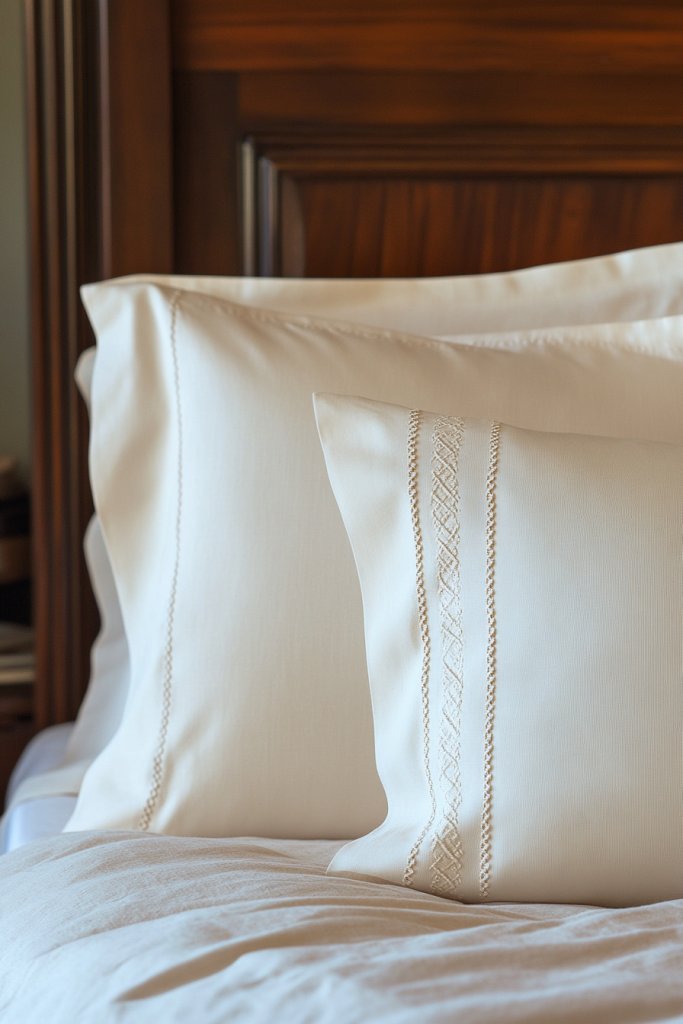
Tired of pillowcases that look cheap or are loaded with synthetic chemicals? Handmade organic pillowcases offer a natural, stylish alternative that elevates your bedding while supporting eco-friendly artisans. Plus, they add a personal touch that mass-produced cases can’t match. Comfort and craftsmanship, all in one.
Picture soft, organic cotton or linen pillowcases with delicate decorative stitching or embroidery along the edges. The natural fibers feel cool and breathable, perfect for restful sleep. The subtle embellishments add sophistication without overwhelming the simplicity of your bedding. When stacked with textured throws, they create a layered, inviting aesthetic.
Choose pillowcases in neutral tones for a minimalist look, or add subtle color accents with eco-friendly dyes. Mix and match different textures—linen, cotton, or hemp—for visual interest. For seasonal variation, swap out pillowcases in darker shades or brighter hues. Use decorative trims or appliqué details for a bespoke feel.
Select pillowcases made from certified organic fabrics, preferably handmade by artisans or small brands. Sew or purchase with decorative stitching in contrasting or matching thread. Use natural dyes or leave uncolored for a classic, understated look. Wash with eco-friendly detergents and avoid harsh chemicals to preserve fibers and color.
Add monograms, embroidered motifs, or hand-stitched patterns to make each pillowcase unique. Incorporate decorative buttons or natural fiber ties for closure or additional detail. Personal touches like small charms or eco-friendly patches can also personalize your bedding.
Handmade organic pillowcases demonstrate your commitment to sustainability and craftsmanship. They promote better sleep hygiene by avoiding synthetic finishes. Every night, you’ll rest on a piece of art that’s as functional as it is beautiful, supporting artisans and the planet.
16. Fair Trade Certified Bedding for Ethical Sourcing
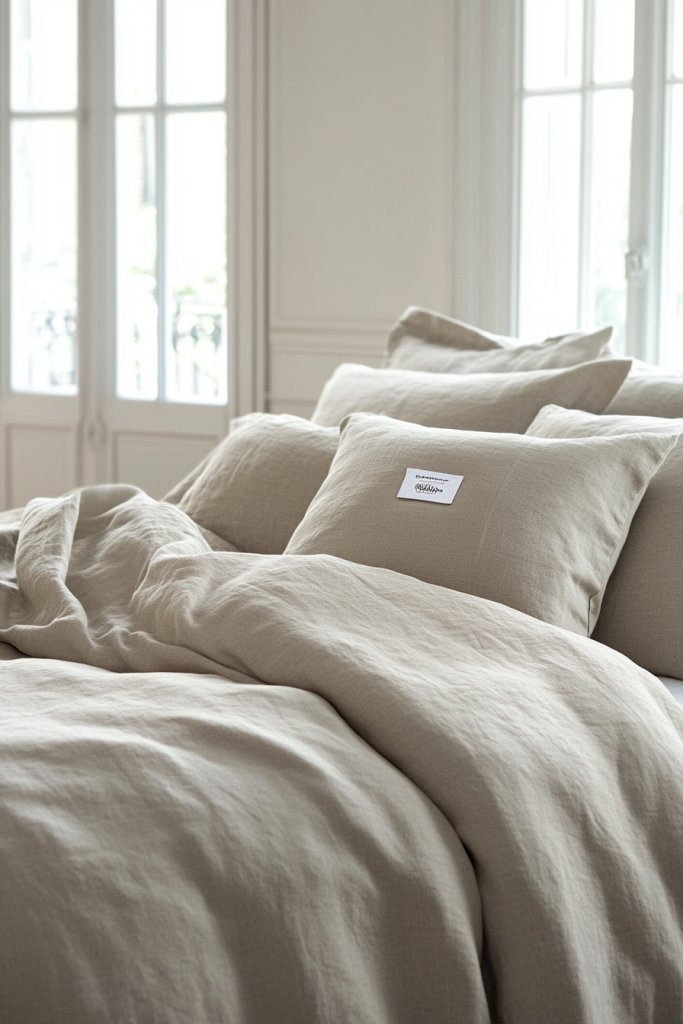
Want to ensure your bedding choices support fair labor practices and sustainable farming? Fair Trade certified bedding guarantees that workers are paid fairly and environmental standards are upheld. It’s more than just fabric; it’s a statement of ethics and responsibility. If you care about the story behind your sheets, this is the way to go.
Imagine bedding made from organic cotton or hemp, with a small, sewn-in tag indicating Fair Trade certification. The fabric feels soft and durable, crafted with care for the planet and its people. The colors are natural or subdued, emphasizing a connection to ethical sourcing. The overall look exudes conscientious luxury, blending style with purpose.
Pair Fair Trade bedding with other eco-friendly accessories like bamboo or reclaimed wood furniture. Use simple, understated designs to let the quality and ethics shine through. Seasonal changes can be made with natural-colored throws or textured pillows that align with sustainable values. It’s a versatile foundation for any eco-conscious bedroom.
Look for bedding brands with official Fair Trade certification, ensuring transparency and accountability. Read product labels carefully—certification logos are your guarantee. Wash with organic, biodegradable detergents to maintain integrity. Support brands that prioritize fair wages, environmentally sound practices, and community development projects.
Add subtle embroidery or eco-friendly patches that highlight the ethical story of your bedding. Use natural fiber trims or decorative borders crafted from recycled materials. Incorporate accessories like handcrafted baskets or furniture that also support fair trade principles. Personal touches reinforce your commitment.
Choosing Fair Trade bedding makes a positive impact beyond your home, supporting fair wages and sustainable agriculture worldwide. It aligns your bedroom aesthetic with your values, creating a truly conscious sanctuary. Every night, you rest with peace of mind, knowing your choices promote justice and sustainability.
17. Layered Bedding with Reclaimed Fabric Accents
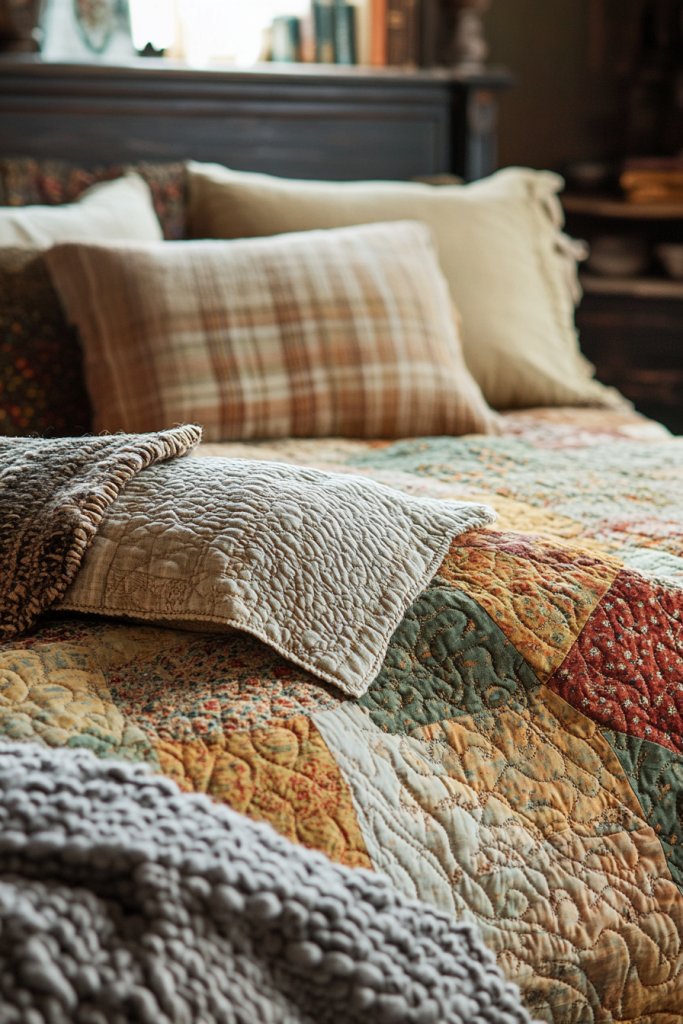
Feeling like your bedroom’s missing that rustic, vintage charm? Layering bedding with reclaimed fabric accents adds a story-rich, eco-friendly touch to your space. It’s a creative way to reuse old textiles and craft a uniquely personal aesthetic. Plus, it’s a small act of sustainability that makes a big design statement.
Visualize a bed covered with a neutral base sheet set, topped with a patchwork quilt of vintage fabrics, and accented with strips of reclaimed linen or chambray along the edges. Small fabric scraps sewn into decorative trims or pillowcases add texture and visual interest. The result is a layered, eclectic look that feels warm, inviting, and full of history. The mix of textures and patterns creates depth and personality.
Use reclaimed fabric accents on pillowcases, throws, or even bed skirts for a rustic or shabby chic vibe. Combine different eras and textiles—vintage floral, denim, or ticking stripes—for a curated, personal style. In colder months, add heavier, textured layers like wool or faux fur. Switch out accents seasonally for fresh variations.
Gather reclaimed fabrics from thrift stores, fabric recycling centers, or old garments. Sew or glue strips of fabric onto existing bedding or create decorative patches on pillowcases. Use eco-friendly thread and avoid synthetic adhesives. Incorporate small decorative elements like buttons or embroidery to enhance visual appeal. Ensure all additions are securely sewn to withstand washing.
Create a story by choosing fabrics with sentimental value or meaningful colors. Add hand-stitched motifs or initials for a personal touch. Mix textures—cotton, linen, wool—to enhance the tactile experience. Display small reclaimed fabric art pieces on the wall or as part of your bedding composition.
Using reclaimed fabric accents demonstrates your commitment to reducing waste while creating a cozy, personalized bedroom. It’s an eco-conscious act that also celebrates craftsmanship and history. Your bed becomes a conversation starter about sustainability and style—beautifully imperfect and uniquely yours.
18. Eco-Friendly Bed Skirts from Natural Fibers
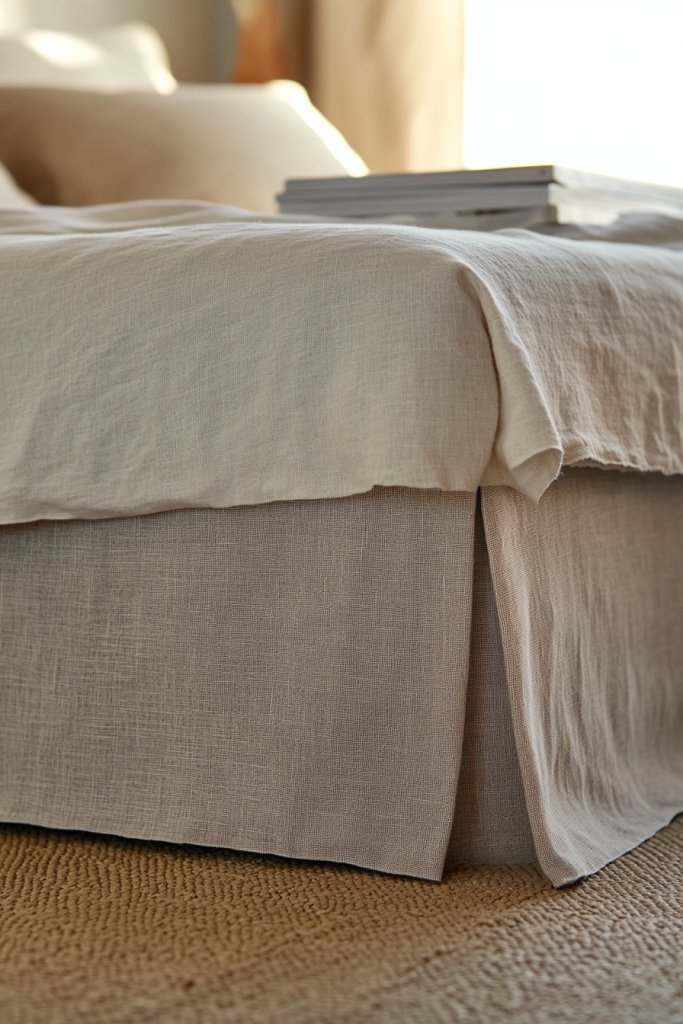
Want to hide under-bed clutter without resorting to plastic or synthetic fabrics? An eco-friendly bed skirt made from natural fibers offers a stylish, sustainable solution. It’s a simple way to achieve a polished look while supporting environmental principles. Plus, it adds a layer of texture and softness to your bedroom decor.
Imagine a flowing bed skirt crafted from organic cotton or hemp, gently draping to the floor in muted earth tones. The natural fibers lend a textured, matte finish that complements wooden or bamboo furniture. It conceals storage boxes or laundry baskets underneath, creating a clean, cohesive aesthetic. The fabric’s subtle weave and organic hue evoke a calm, grounded atmosphere.
Choose minimalist, unadorned skirts for a modern, Scandinavian look, or add decorative trims or embroidery for a personalized touch. Use multiple layers or contrasting textures for visual interest. Swap out seasonal colors or fabrics—linen in summer, wool blends in winter—for versatility. Pair with eco-friendly bedding and natural decor to complete the look.
Select bed skirts made from certified organic or recycled fibers, ensuring sustainability. Measure your bed frame accurately to determine the right length and fullness. Attach with eco-friendly fasteners or sew directly onto the mattress platform. Launder with gentle, plant-based detergents to preserve fibers and color. Ensure the fabric is securely hemmed to prevent fraying.
Add decorative trims, embroidery, or natural fiber tassels for a bespoke appearance. Use eco-friendly dyes or leave raw for a natural look. Incorporate small fabric tags with eco-messages or symbols of sustainability. Pair with matching organic pillow shams for a coordinated, eco-conscious bedroom ensemble.
A natural fiber bed skirt elevates your bedroom’s style while supporting eco-friendly practices. It helps maintain a clutter-free space with a minimal environmental footprint. You can feel good about your design choices, knowing they reflect your values and commitment to sustainability.
19. Natural Bedding Care with Plant-Based Detergents
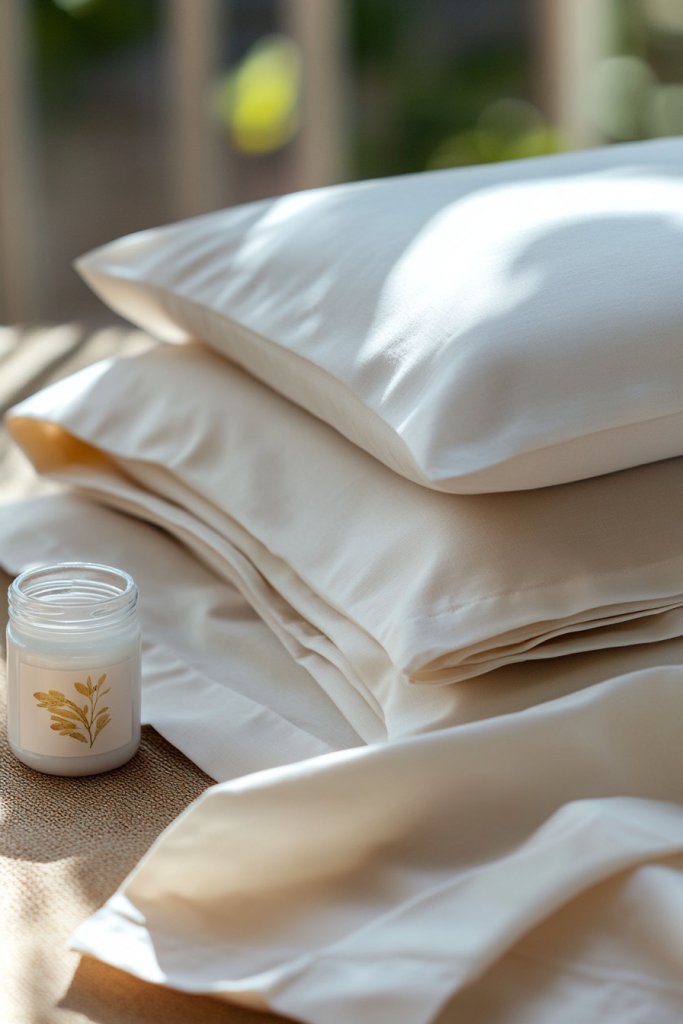
Ever wonder if your bedding is truly clean and chemical-free? Using plant-based detergents ensures your sheets stay fresh without exposing you or the environment to toxic residues. It’s an essential step in maintaining eco-friendly bedding and prolonging its lifespan. Cleanliness and sustainability go hand in hand here.
Imagine washing your bedding in a gentle, biodegradable detergent derived from natural ingredients like eucalyptus or citrus. The subtle scent of botanicals fills your laundry space, replacing overpowering chemical fragrances. Your linens emerge soft, fresh, and toxin-free, ready to cocoon you in comfort. The process feels pure, aligning with your eco-conscious lifestyle.
Choose detergents suitable for delicate natural fibers like linen, hemp, or wool. Use eco-friendly fabric softeners or natural wool conditioners to enhance softness without chemicals. For sensitive skin or allergies, select unscented, hypoallergenic options. Adjust water temperature and washing cycle based on fabric type for maximum longevity.
Select plant-based detergents certified by eco-labels like USDA Organic or EcoCert. Follow manufacturer instructions for dosage—more isn’t necessarily better—and always wash in cold water to conserve energy. Avoid synthetic fragrances, optical brighteners, and harsh surfactants. Regularly clean your washing machine to prevent buildup that can transfer to your linens. Store detergents in a cool, dry place away from sunlight.
Create your own natural laundry scents using essential oils like lavender or tea tree. Use small cloth sachets filled with dried herbs or flowers to infuse linens with subtle aromas. Label your eco-friendly detergents with personalized tags to remind yourself of your commitment. Incorporate biodegradable fabric softener sheets or natural wool balls for added softness.
Choosing plant-based detergents reinforces your dedication to a sustainable, toxin-free home. It supports healthier skin, especially for sensitive individuals. Maintaining your bedding with eco-friendly products ensures its beauty and freshness for years to come. Every wash becomes a small act of kindness to the planet.
Conclusion
Exploring these diverse natural bedding ideas can inspire you to craft a bedroom that’s both beautiful and environmentally friendly. Whether you opt for organic fabrics, eco-friendly dyes, or handcrafted textures, each choice adds a layer of comfort and sustainability to your space. Embrace these ideas and take the first step toward a more natural and restful haven—your perfect sleep sanctuary awaits!






